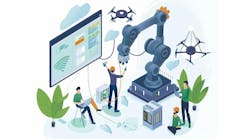Base Camp Digital preview: Removing Obstacles to IIoT at Scale
Take a look…
Smart Industry: What is the most common obstacle to properly scaling IIoT projects?
Travis: Trying to attack IIoT without first solving OT's infrastructure and needs. Many IIoT projects tend to be led by IT reaching down to OT, which results in more silos of information and no single source of truth for process variables. Start small with an overall OT-infrastructure plan in mind that is inherently scalable. Solve OT first, then move to IT.
Smart Industry: Do business leaders over or underestimate the challenge of IIoT projects?
Travis: Our industrial customers have more than 35 years of legacy/tribal knowledge wrapped up in OT infrastructures that need to be addressed before starting any IIoT project. Many business executives are shown elegant dashboards and infrastructure topologies that make everything look simple. But without intimate involvement from OT to understand the underlying complexities, the effort is vastly underestimated.
Smart Industry: Can scalable IIoT systems be implemented at any type of manufacturing enterprise? Small and large?
Travis: Small manufacturers might have the luxury of applying IIoT technology to their entire line while larger enterprises should develop an overall plan to migrate into their final architecture with a minimum number of disruptions. Both small and large enterprises should involve both OT and IT in a migration strategy that considers manufacturing-downtime risks and minimizes any operational risks from a command/control/safety view. These migration strategies are definitely doable and result in a much more successful IIoT solutions.
Smart Industry: Are legacy assets still a hindrance to successful, simply launched IIoT projects or does modern software/hardware overcome that issue?
Travis: Regardless of whether legacy/brownfield assets are a hindrance or not, they have to be addressed since they will be in place throughout the next decade. Proper modern software platforms and tools on those platforms that directly address the unique aspects of legacy assets enable customers to reduce overall implementation costs while maintaining the support of their legacy assets currently deployed.
Smart Industry: How do mobile solutions factor into all of this?
Travis: Mobile-device applications for tablets and smartphones increasingly are entering the industrial space and are changing the way we acquire, view, store, analyze and act on data and information. The adoption of mobile devices far exceeds tablets and desktops and is the preferred computing platform today. The younger workforce expects to leverage their mobile device not just in their personal lives but at work as well. Mobility allows greater access and greater value.
Smart Industry: How do you define a "digital-first mindset"? Why is this critical to instill in your workforce?
Travis: I think it’s the realization that we’re emerging from 35 years of just “monitoring and controlling” a process with embedded computers. Flow computers, PLCs, RTUs, manufacturing equipment, etc. used the first generation of embedded computers to simply replace analog/mechanical control with embedded computers. So these embedded computers “encapsulated basic process variable knowledge” and provided us with those PVs via a poll/response protocol. But in all of the legacy infrastructure, IT integrations and communications connectivity were, at best, an effort in hindsight. In most cases they were ignored altogether. With a “digital-first mindset” employees need to be able to think beyond the basic process/sensor information that machine can provide “just” for operations. They should think about how this information could be utilized by other individuals in the enterprise to improve the overall process. I think that with modern OT technology, we’re giving these “digital-first” individuals the tools and technology to do exactly that.





